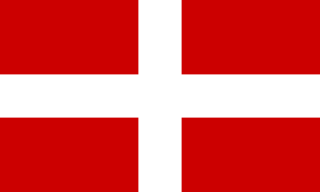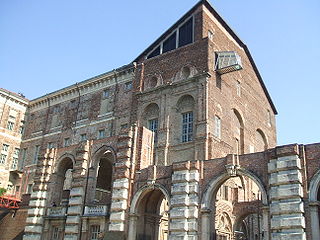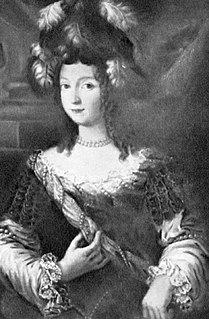
The House of Savoy is a royal dynasty that was established in 1003 in the historical Savoy region. Through gradual expansion, the family grew in power from ruling a small Alpine county north-west of Italy to absolute rule of the Kingdom of Sicily from 1713 to 1720, when they were handed the island of Sardinia, over which they would exercise direct rule from then onward.

Guillaume Du Fay was a French composer and music theorist of the early Renaissance. Regarded as the leading European composer by his contemporaries, his music was widely performed and copied. Du Fay held various music positions during his lifetime, and was associated with the Burgundian School as well as among the first composers of, or at least a predecessor to, the Franco-Flemish School.

Filippo Juvarra was an Italian architect, active in a late-Baroque style, who worked primarily in Italy, Spain, and Portugal.

From 1416 to 1847, the Duchy of Savoy was a country in Western Europe. It was created when Sigismund, King of the Romans, raised the County of Savoy into a duchy for Amadeus VIII. The duchy was an Imperial fief, subject of the Holy Roman Empire with a vote in the Imperial Diet. From the 16th century, Savoy belonged to the Upper Rhenish Circle. Throughout its history, it was ruled by the House of Savoy and formed a part of the larger Savoyard state, which in 1720 became the Kingdom of Sardinia.

Saluzzo is a town and former principality in the province of Cuneo, in the Piedmont region, Italy.

Giovanni Matteo De Candia, also known as Mario, was an Italian opera singer. The most celebrated tenor of his era, he was lionized by audiences in Paris and London. He was the partner of the opera singer Giulia Grisi.

The Palazzina di caccia of Stupinigi is one of the Residences of the Royal House of Savoy in northern Italy, part of the UNESCO World Heritage Sites list. Built as a royal hunting lodge in the early 18th century, it is located in Stupinigi, a suburb of the town of Nichelino, 10 km (6 mi) southwest of Turin.

Rivoli is a comune (municipality) established around the 1st century CE, in the Metropolitan City of Turin in the Italian region Piedmont, about 14 kilometres (9 mi) west of Turin. As of 1-1-2017, it had a population of 48,798.

The Residences of the Royal House of Savoy are a group of buildings in Turin and the Metropolitan City of Turin, in Piedmont. It was added to the UNESCO World Heritage Sites list in 1997.

Giaveno is a comune (municipality) in the Metropolitan City of Turin in the Italian region Piedmont, located about 30 kilometres (19 mi) west of Turin.

Cirié is a comune (municipality) in the Metropolitan City of Turin in the Italian region Piedmont, located about 20 kilometres (12 mi) northwest of Turin.

The Castle of Rivoli is a former Residence of the Royal House of Savoy in Rivoli. It is currently home to the Castello di Rivoli – Museo d'Arte Contemporanea, the museum of contemporary art of Turin.

Stupinigi, with some 200 inhabitants, is today a hamlet of the comune of Nichelino, in the Metropolitan City of Turin. It borders with the comuni (municipalities) of Candiolo and Orbassano on the southwestern outskirts of Turin, about 10 km from the centre of the city. Before 1869, it formed part of the comune of Vinovo.

The Royal Palace of Turin is a historic palace of the House of Savoy in the city of Turin in Northern Italy. It was originally built in the 16th century and was later modernized by Christine Marie of France (1606–1663) in the 17th century, with designs by the Baroque architect Filippo Juvarra. The palace also includes the Palazzo Chiablese and the Chapel of the Holy Shroud, the latter of which was built to house the famous Shroud of Turin. In 1946, the building became the property of the state and was turned into a museum. In 1997, it was placed on the UNESCO World Heritage Site list along with 13 other residences of the House of Savoy.

The Palace of Venaria is a former royal residence and gardens located in Venaria Reale, near Turin in the Metropolitan City of Turin of the Piedmont region in northern Italy. With 80,000m² in palace area and over 950.000m² in premises, it is one of the largest palaces in the world. It is one of the Residences of the Royal House of Savoy, included in the UNESCO Heritage List in 1997.

Turin is a city and an important business and cultural centre in northern Italy. It is the capital city of Piedmont and of the Metropolitan City of Turin, and was the first Italian capital from 1861 to 1865. The city is mainly on the western bank of the Po River, below its Susa Valley, and is surrounded by the western Alpine arch and Superga Hill. The population of the city proper is 847,033 while the population of the urban area is estimated by Eurostat to be 1.7 million inhabitants. The Turin metropolitan area is estimated by the OECD to have a population of 2.2 million.

The Villa della Regina is a palace in the city of Turin, Piedmont, Italy. It was originally built by the House of Savoy in the 17th century.

Villa I Tatti, The Harvard Center for Italian Renaissance Studies is a center for advanced research in the humanities located in Florence, Italy, and belongs to Harvard University. It houses a collection of Italian primitives, and of Chinese and Islamic art, as well as a research library of 140,000 volumes and a collection of 250,000 photographs. It is the site of Italian and English gardens. Villa I Tatti is located on an estate of olive groves, vineyards, and gardens on the border of Florence, Fiesole and Settignano.

Princess Luisa Cristina of Savoy was a Princess of Savoy by birth and the eldest daughter of Victor Amadeus I, Duke of Savoy. She married her uncle Prince Maurice of Savoy but had no children. She was the owner of the future Villa della Regina. She was a first cousin of Louis XIV of France and Charles II of England.

The Palazzo Chiablese is a wing of the Royal Palace of Turin, in Northwest Italy.



















